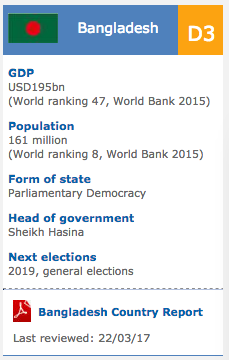China: China Agriculture Profile
2017/07/23

Winter wheat conditions in 2017 mostly favourable with exception of southwest regionPlanting of the winter wheat crop was completed in October 2016 and the harvest is expected to start from May 2017.
This crop accounts for about 95 % of the total wheat production. Winter wheat is currently at re-greening to jointing stage in the major producing regions. Crop conditions are favourable in major producing areas of Northern China due to proper agro-climatic conditions, while excessive rains and low radiation have negatively affected crops in Southwest China.
Accumulation cereal production in 2017 is tentatively set at 563.5 million tonnes, slightly below last-year level. Maize production is expected to decline as a consequence of the policy reform of supply structure in 2017.
Under the new supply structural reform, the Government’s support to rice and wheat production will continue in 2017. On 18 February, the Government announced the minimum purchase prices for rice in 2017 as follows: for early Indica rice at CNY 2 600 (USD 378), medium and late Indica at CNY 2 720 (USD 396) and Japonica rice at CNY 3 000 (USD 437). The minimum purchase price for winter wheat was set at CHY 2 360 (USD 344), announced on 21 October 2016.
Cereal production in 2016 estimated to decrease marginally
The 2016 accumulation cereal production is estimated at about 566 million tonnes, down 2 % compared to 2015. The new official estimate for the 2016 paddy output, harvested by last November, points at 206.9 million tonnes, slightly below the previous year’s record level. The small contraction mirrors reduced yields, following unfavourable weather conditions during the growing season. Similarly, the 2016 wheat production is estimated at 128.6 million tonnes, 1.6 million tonnes below the previous year’s level. Despite the impact on production by the Government’s decision to end maize procurement at high minimum support prices, the 2016 maize output is set at 219.6 million tonnes, some 5 million tonnes below the previous year’s record, but still higher than the five-year average.
Cereal imports in 2016/17 estimate sharply down from 2015/16 record level
Total cereal imports in the 2016/17 marketing time(July/June) are currently foreseen to fall by 32 % to 21.3 million tonnes compared to the exceptionally high level of the previous year. The bulk of the decline is on account of falling purchases of barley and sorghum from the international market due to expectations of the much larger use of domestic maize for feed in view of the Government’s plan to cut its inventories. As a result, imports of barley and sorghum, the major grains used for feed, are estimate to fall by 43 % to 4.6 million tonnes and 46 % to 4.5 million tonnes, respectively, in the 2016/17 marketing year. Similarly, imports of maize are currently foreseen to decrease by almost 68 % to 1 million tonnes. Strong domestic request for premium quality wheat is seen to keep wheat imports high at 3.7 million tonnes during the 2016/17 marketing time(June/May). Rice imports in schedule year 2017 are estimate at over 6 million tonnes, similar to last year’s high level, as a result of the Government’s efforts to limit informal inflows of rice across borders.
Prices of rice and wheat stable in recent months
Retail prices of Japonica rice and wheat flour, major food crops, were generally stable with a slight increase only in recent months, reflecting adequate availabilities and seasonality. In general, quotations were about 5 % above their year‑before levels. Wholesale prices of maize, the major feed crop, were lower (6.7 %) compared with the same period of the previous year as a result of the change of the Government’s maize production policy. The data shows that the price of pork in March was about 7 % lower and the price of cabbage was about 46 % lower compared to a year before. These will be beneficial to the food consumption of the poor and low gain families.
- China News
-
- CHINA: Life after Rosneft deal: CEFC ambitions face debt, regulatory hurdles
- CHINA: Life after Rosneft deal: CEFC ambitions face debt, regulatory hurdles
- CHINA: Former Fed official Fisher: China could be the key to solving the North Korea crisis
- CHINA: Zhongwang Acquires German Alumnium Extrusion Firm ALUnna
- CHINA: China’s Aluminium Production Drops for Second Consecutive Month
- CHINA: China to Loan Guinea US$20 Billion for Access to Bauxite Reserves
- Trending Articles
-
- EUROPEAN UNION: UK seeks to 'align' with EU on data protection rules
- ANGOLA: Angola: Elections / 2017 - Provisional Data Point Out Qualified Majority for MPLA
- BAHRAIN: Bahrain issues new rules to encourage fintech growth
- CHINA: Chinese-supported infrastructure projects change Zambia's landscape
- CHINA: China’s Aluminium Production Drops for Second Consecutive Month
- KENYA: Kenya to hold fresh presidential election on October 17











